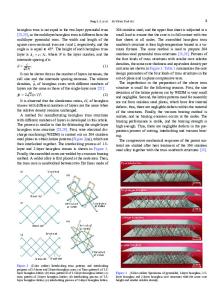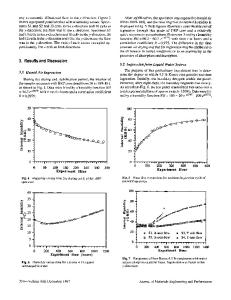Cellular Truss Core Sandwich Structures
- PDF / 838,420 Bytes
- 18 Pages / 595 x 842 pts (A4) Page_size
- 91 Downloads / 347 Views
© Springer 2005
Cellular Truss Core Sandwich Structures DAVID J. SYPECK Aerospace Engineering Department, Embry-Riddle Aeronautical University, 600 S. Clyde Morris Blvd., Daytona Beach, FL 32114, USA. e-mail: [email protected] Abstract. Sandwich structures with open cell truss cores are a relatively new class of multifunctional material systems that can be made using affordable deformation, assembly and joining processes. A variety of cellular core architectures have recently been made from wrought metal alloys using inexpensive textile and perforated sheet methods. Here, the design, fabrication and properties for these types of structures is reviewed. Key words: sandwich structure, cellular solid, multifunctional, alloy, brazing.
1. Cellular solids Lessons learned from nature often provide inspiration for technological advance. Attachment of Cocklebur plant (Xanthium strumarium L.) burrs to clothing (Velcro® [1]), the maneuverability gained by twisting of a bird’s wing in flight (shape morphing smart wing [2]), or the numerous hexagonal cells within a bee’s nest (structural honeycomb [3]) are just a few examples. The word “cell” derives from the Latin word cella meaning a small compartment or enclosed space [3]. When nature constructs things, it is often done from many cells (cellula). Wood, cancellous bone and sponge are good examples of this. Consider the bovine femur shown in Figure 1(a). It is stiff, strong, lightweight and multifunctional. This is just one of nature’s many cellular structures. From these natural inspirations have evolved synthetic cellular solids, Figure 1(b) [4]. A variety of synthetic cellular solids have been made including stochastic foams, consolidated powders, gasars, vapor deposited materials, hollow sphere structures, honeycombs, prismatic materials, textile laminates and lattice block or miniature truss structures [5–8]. The most common and least expensive are made from polymers. These have a stochastic cellular architecture and are often used for cushioning, thermal insulation, filtering, structural applications or for their buoyancy property amongst many other applications. Others find application as impact energy absorbers, cores of composite structural panels and even hanging household decorations. See [3] for a comprehensive treatment of the subject. Most stochastic foams are made by variants of foaming in the liquid, solid or semi-solid state. Since it is difficult to control placement of the solid material at the cell level, they normally possess a random pore architecture with non-uniform, curved cell walls/ligaments and numerous defects [9, 10]. In Figure 2, interior
230
DAVID J. SYPECK
Figure 1. (a) Juvenile bovine femur. (b) Synthetic open cell aluminum foam (Duocel® , ERG Inc., Oakland, CA) [4].
features within a closed cell stochastic aluminum foam are readily seen using a medical CT scanner [9]. Observe the wide variation in cell shape, size and wall thickness. Note that drainage during the solidification process has led to increased density near the base of the sa
Data Loading...











